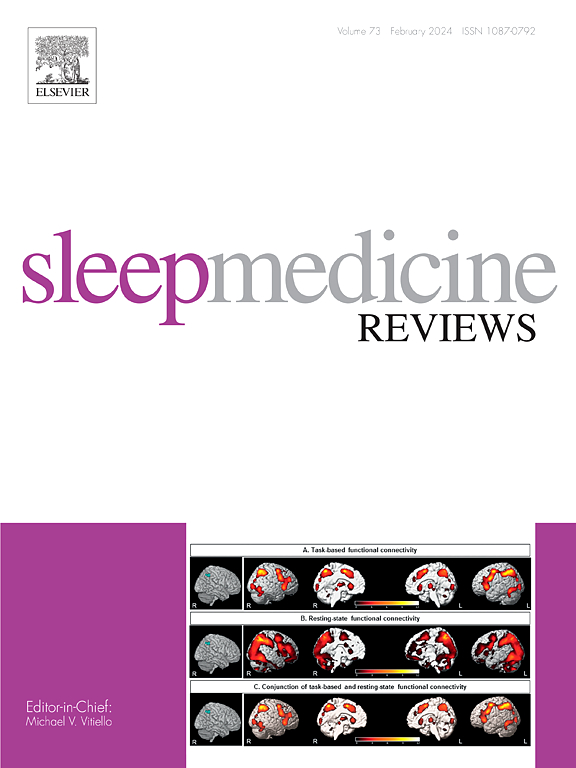失眠症全球患病率和负担的估计:基于文献综述的系统分析
IF 9.7
1区 医学
Q1 CLINICAL NEUROLOGY
引用次数: 0
摘要
失眠很常见,与主要的不良医疗和心理健康结果有关,对生活质量有负面影响,并具有重大的经济后果。然而,人们对全球失眠负担知之甚少。本系统综述估计了全球成年人失眠的患病率。检索PubMed和Embase(术语“失眠”、“患病率”和“一般人群”)以确定相关的同行评审研究(最终检索于2024年9月2日至3日)。纳入的研究具有最高的数据质量和最低的偏倚风险,并报告了一般人群中临床相关的失眠患病率。失眠患病率估计值应用于联合国(UN)人口数据,使用特定国家的研究(如果有)或最高质量的研究(如果没有特定国家的研究)。在1651项潜在记录中,纳入了18项研究(262582名参与者)。在237个联合国/世界银行承认的国家/地区中,有31个国家/地区有适合本国的成人失眠症患病率估计。估计有852,325,091名成年人(95%置信区间为830,354,161-874,309,252)患有失眠症(全球患病率:16.2%),估计有414,967,941名患有严重失眠症(7.9%)。在所有年龄组中,失眠症和严重失眠症在女性中比男性更普遍。失眠症的全球高患病率加强了全球范围内全面的公共卫生和临床睡眠健康倡议的必要性。RegistrationPROSPERO: CRD42024581410。本文章由计算机程序翻译,如有差异,请以英文原文为准。
Estimation of the global prevalence and burden of insomnia: a systematic literature review-based analysis
Insomnia is common, is associated with major adverse medical and mental health outcomes, has a negative impact on quality of life, and has significant economic consequences. However, little is known about the global insomnia burden. This systematic review estimated the global prevalence of insomnia in adults. PubMed and Embase were searched (terms “insomnia,” “prevalence,” and “general population”) to identify relevant peer-reviewed studies (final search 2–3 Sep 2024). Included studies had the highest data quality and lowest risk of bias, and reported clinically relevant insomnia prevalence in the general population. Insomnia prevalence estimates were applied to United Nations (UN) population data using a country-specific study (if available) or the highest-quality study (if no country-specific study). Of 1651 potential records, 18 studies (262,582 participants) were included. Thirty-one of 237 UN/World Bank-recognized countries/territories had a suitable nation-specific adult insomnia prevalence estimate. 852,325,091 adults (95 % confidence interval 830,354,161–874,309,252) were estimated to have insomnia (global prevalence: 16.2 %) and 414,967,941 were estimated to have severe insomnia (7.9 %). Insomnia and severe insomnia were more prevalent in females versus males across all age groups. The high global prevalence of insomnia disorder reinforces the need for comprehensive public health and clinical sleep health initiatives worldwide.
Registration
PROSPERO: CRD42024581410.
求助全文
通过发布文献求助,成功后即可免费获取论文全文。
去求助
来源期刊

Sleep Medicine Reviews
医学-临床神经学
CiteScore
20.10
自引率
3.80%
发文量
107
期刊介绍:
Sleep Medicine Reviews offers global coverage of sleep disorders, exploring their origins, diagnosis, treatment, and implications for related conditions at both individual and public health levels.
Articles comprehensively review clinical information from peer-reviewed journals across various disciplines in sleep medicine, encompassing pulmonology, psychiatry, psychology, physiology, otolaryngology, pediatrics, geriatrics, cardiology, dentistry, nursing, neurology, and general medicine.
The journal features narrative reviews, systematic reviews, and editorials addressing areas of controversy, debate, and future research within the field.
 求助内容:
求助内容: 应助结果提醒方式:
应助结果提醒方式:


